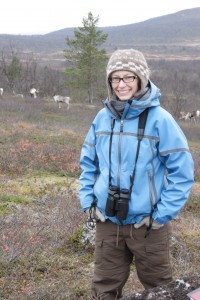 Natalka Melnycky
Natalka Melnycky
MSc. Student
Contact Information
Department of Biology
Concordia University (Loyola Campus)
7141 Sherbrooke St. W. H4B 1R6
Montreal, QC, Canada
Office: SP301.16
Lab: SP434
(514) 848-2424 (ext. 4021)
Education
2010 – Present: Biology Graduate Student at Concordia University, Montreal
2003 – 2008: BSc. Biology, Specialized in Environmental Biology, University of Alberta, Edmonton
My Project
Allometric growth in secondary sex traits of reindeer: tradeoffs when allocating resources
Background
Patterns of resource-allocation are essential to understanding life-history traits of an animal. Nutritional efforts should be directed towards phenotypic traits which maximize an animal’s lifelong reproductive success as with secondary sexual traits (SSTs) such as antlers. Resources are rarely unlimited, thus tradeoffs between body mass and antlers are expected in sexually dimorphic ungulates, as both are important life history traits reflective of dominance, good foraging skills, fighting success and increased reproductive success. Body mass and antler size are not mutually exclusive however, as increased body mass is correlated with increased antler size. Thus, comparisons of absolute measurements are not appropriate. The use of allometry -the relative growth of a trait- is one way to investigate these tradeoffs and with which comparisons to other populations is possible. Secondary sexual traits are assumed to be under the influence of positive allometry but age- and sex- patterns have not been established in reindeer (Rangifer tarandus). Within the Cervidae family, reindeer/caribou are the only female deer to develop antlers, providing a system in which resource allocations towards SSTs can be compared between sexes as well as ages. Some individuals can have an apparent absence of costs of antler growth. This may be accounted for by heterogeneity of individual quality and resource allocations. I will establish sex- and age-specific growth patterns of antlers using absolute measurements as well as allometric equations. The variance of individual quality will be established and I will also investigate the use and shape of antlers in females in order to further discuss their evolutionary significance.
Field work
We will be studying a reindeer population from the Kutuharju Field Reindeer Research Station in Kaamanen, Finland (69°N, 27°E). This herd is composed of semi-domestic reindeer that are free ranging for most of the year excluding the calving and rutting periods. These animals are managed and harvested by the Finnish Reindeer Herders Association, therefore, we are able to continuously gather information on the ecology and behaviour of the individual reindeer. See pictures on this web page
Objectives
The objectives of this study are to examine the resource allcoations towards SSTs (antlers) in life-history strategies in reindeer (Rangifer tarandus);
1) Establish age- and sex-specific growth patterns of antlers and body size;
2) Establish age- and sex-specific allocations of resources to SSTs through allometry ;
3) Document heterogeneity in individual quality by establishing the relationship between allometric exponents and quality traits (longevity, offspring birth weight and adult body mass)
4) Document intra-specific antagonistic encounters of females during rut and confirming resemblance of adult female antlers to yearling males.
Publications
- Natalka A. Melnycky*, R.B. Weladji, Øystein Holand & Mauri Nieminen (2013) Scaling of antler size in reindeer (Rangifer tarandus): sexual dimorphism and variability in resource allocation. Journal of Mammalogy In-Press. doi: http://dx.doi.org/10.1644/12-MAMM-A-282.1.
- N. Melnycky, R.B. Weladji, Ø. Holand & M. Nieminen (2011) Allometric growth in secondary sex traits: tradeoffs when allocating resources. 36e congrès annuel pour le Société Québéçoise pour l’Étude Biologique du Comportement, 4-6 November, 2011, Sherbrooke, Québec, Canada (Page 10; oral presentation).
- N. Melnycky, R.B. Weladji, Ø. Holand & M. Nieminen (2011) Using allometry to infer age- and sex-specific resource allocations towards antlers in reindeer (Rangifer tarandus). Presentation at the 13th Arctic Ungulate Conference, August 22 to 26, 2011, Yellowknife, Northwest Territories, Canada (Page 44; oral presentation)
- R. Errington, J. Bhatti, N. Melnycky. (2010). Lichen biomass estimation and trends across topographically- and climatically-induced permafrost gradients in the Mackenzie Valley of north-western Canada. Poster presented at the International Polar Year Canada Early Results Workshop, February 16-18, Ottawa, ON, Canada.
- N.Melnycky,R. Weladji, Ø. Holand, M. Nieminen. (2011). Allometric growth in secondary sexual traits of reindeer: tradeoffs when allocating resources. Annual Meeting of the Canadian Society for Ecology and Evolution, May 12-15, 2011, Banff, Alberta, Canada (Page 57; poster)